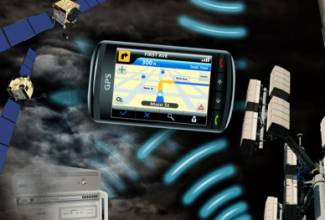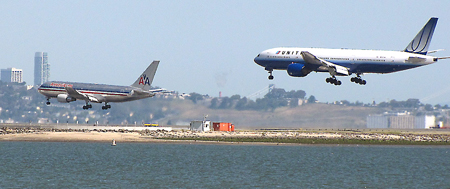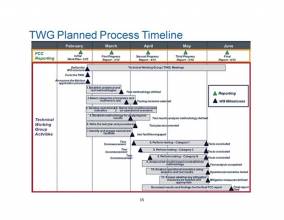LightSquared submitted a 318-page report to the Federal Communications Commission (FCC) yesterday (June 30, 2011) on the months-long effort of a technical working group (TWG) to investigate the effects of the would-be cellular broadband company’s terrestrial transmitters on GPS receivers operating in an adjacent RF band.
LightSquared submitted a 318-page report to the Federal Communications Commission (FCC) yesterday (June 30, 2011) on the months-long effort of a technical working group (TWG) to investigate the effects of the would-be cellular broadband company’s terrestrial transmitters on GPS receivers operating in an adjacent RF band.
The report, and an additional 435 pages of appendices outlining the tests designs and results from seven sub-teams, demonstrated widespread adverse effects by LightSquared transmissions on all categories of receivers tested. The test program included laboratory simulations, anechoic chamber trials, and "live" open-air transmissions.
Nonetheless, in a 58-page recommendation and appendix giving the company’s spin on the TWG report, LightSquared — which the FCC had given sole authority for filing the official report and recommendation — argued that it should be allowed to proceed with its plan to roll out a dense nationwide network of transmitters.
In January, the FCC waived restriction against the terrestrial transmitters in the 1525-1559 MHz band allocated for space-to-Earth satellite communications and issued an order that allowed LightSquared to proceed with its plans at the same time, requiring the meantime formation of the working group to look into the GPS interference issue.
In its June 30 recommendation, LightSquared offered to temporarily broadcast only in a 10-megahertz swath in the lower portion of its spectrum in the 1525-1559 MHz band, making the rather remarkable claim in light of the details in the TWG report that operations on the lower 10 megahertz “poses no risk to the users of over 99 percent of GPS devices. . . .” It offered no documentation to substantiate the latter claim.
Moreover, the company said it still “intends ultimately to deploy a network using a full complement of terrestrial frequencies operating at appropriate power levels, in order to provide LTE capacity and service levels to its customers. . . .”
LightSquared used most of the 58 pages to attack what it refers to as “the commercial GPS device industry,” argue the procedural merits of its application to the FCC, and reassert the great economic value that its proposed system will bring about.
The company, backed by the Harbinger hedge fund, argued that the TWG resting illustrated “conclusively that the problem is one of GPS device design and characteristics, rather than an issue of fundamental incompatibility between LightSquared’s planned transmissions and all GPS receivers.”
Not unexpectedly, the GPS community responded critically to LightSquared’s recommendation to the FCC.
“Based on the analysis performed, LightSquared should not be permitted to use the L‐Band spectrum for a densely‐deployed, non‐integrated terrestrial‐only network,” the U.S. GPS Industry Council (USGIC) said in a June 30 statement. The lobbying organization participated in the FCC Working Group and its chairman, Charles Trimble, cochaired the working group with LightSquared Executive Vice President for Regulatory Affairs and Public Policy Jeff Carlisle.
“Such a network would cause unacceptable interference to GPS operations, wiping out an installed base of over 500 million units used in a wide array of public safety, aviation, industrial and consumer applications,” the USGIC statement continued. “While mitigation techniques utilizing filters were discussed in theory, they could not be tested as part of the WG effort because filters do not exist, even in prototypes. No information considered by the WG demonstrated that any mitigation techniques – other than relocation of the proposed terrestrial network to an alternative band – would be successful.”
Regarding future GPS and broadband developments, Trimble said, “We hope that the FCC will understand and appreciate the comprehensive work that the TWG has done to define the interference effects of the LightSquared signals in scientific and engineering fact. GPS and broadband are two very valuable elements of today’s information infrastructure, but the report shows clearly that they cannot operate in adjacent spectrum.
“Finding new areas of spectrum where sharing is possible to accommodate the LightSquared requirements is a difficult regulatory question. However, the FCC needs to consider other options for the LightSquared signals where they do not run up against the laws of physics.”
The Coalition to Save Our GPS, an advocacy group that arose in the wake of the FCC’s action, was similarly harsh in its assessment of the LightSquared proposal.
“The utter failure of LightSquared’s initial deployment plans to pass interference tests raises fundamental questions about the representations LightSquared made to the FCC prior to its January 2011 decision that convinced the FCC to grant the waiver and convene the interference study process in the first place, and raises significant questions about the credibility of LightSquared’s various claims and whether they hold up to scrutiny,” the coalition said in a press release today (July 1, 2011).
“In [its recommendation to the FCC], LightSquared proposed an entirely new deployment scenario, not included in the initial scope of the working group analysis, which would not use the Upper MSS band at all, and a series of mitigation measures – many of which were never disclosed or discussed during the four month working group study process.”
The coalition statement ended by saying, “While the nation needs more wireless broadband services, there are many places in the radio spectrum already identified or allocated to 4G cellular uses, where interference to adjacent space based communications such as GPS would not occur.
“The satellite component of LightSquared’s network — serving rural and public safety users outside of cellular coverage — is fully compatible with the adjacent uses and is already in use. To allow a new unproven use for fewer users to diminish a long-established, highly productive spectrum use for the majority is not in the public interest and must not be allowed.”
Some excerpts from the TWG Report:
Aviation Sub-Team
Based on the approach outlined above, the Aviation Sub-team concluded that all three phases of the currently proposed LightSquared deployment plan are incompatible with aviation GPS operations absent significant mitigation. . . .
Analysis performed by RTCA suggests that a shift to using only a lower 5 MHz channel likely would be compatible with aviation GPS operations provided that ATC transmissions are kept at or below proposed levels of 32 dBW EIRP.
While not studied by RTCA, a shift in the LightSquared ATC frequency to spectrum that is not adjacent to the GPS band could eliminate all interference concerns for aviation GPS.
The Aviation Sub-team also studied the potential for improvements in GPS receiver selectivity using new filter technology. Such improvements could not be tested because the new filter technology is not available at this time. This mitigation strategy could take many years to design, obtain FAA airworthiness certification, and install new airborne equipment in a manner consistent with FAA requirements. The aviation representatives on the sub-team believe, based on past experience with programs for modification of certified systems with safety or operational benefits that this process would take at least 8-10 years. LightSquared believes that the process could take significantly less time,
Cellular Sub-Group
Enough test data was available to demonstrate that LightSquared signals in the higher 5 MHz and 10 MHz band (1545.2 to 1555.2 MHz) caused GPS failure for a significant number of the tested devices. In contrast, the current test data and analysis to date indicates that operations in the lower bands (1526 to 1536 MHz) may be possible without harmful interference to existing cellular GPS devices.
However, filtering technology may be available to reduce susceptibility to adjacent band signals into the GPS receivers of future cellular devices. . . . Until these filters and other mitigation techniques are developed and implemented, it is reasonable to expect that a significant number of mobile devices would continue to be vulnerable to interference from LightSquared‘s upper band operations.
General Location and Navigation
There were significant areas within Section 3.3.4 of this Final Report (General Location and Navigation) where LightSquared and the sub-team could not reach agreement. Where different perspectives exist, they are clearly labeled as the ―GPS Industry Perspective or ―LightSquared’s Perspective.
GPS Industry Perspective
The General Location/Navigation sub-team has concluded that all phases of the LightSquared deployment plan will result in widespread harmful interference to GPS signals and service and that mitigation is not possible.
Lab testing revealed that many devices suffered from harmful interference from the lower 10 MHz channel; specifically, 20 out of 29 devices experienced harmful interference.
Several simulated filters were proposed as options for GPS receivers; however, no testing could be performed since these parts do not exist. While claiming marginal improvements in rejection of the LightSquared signals, these simulated filters did so at the expense of increased degradation of GPS signals. As a result of these efforts, the General Location/Navigation sub-team has concluded that no mitigations exist for the existing user base or for future products as long LightSquared remains in the MSS L-band. The only option for coexistence with GPS is for LightSquared to move to another frequency band.
High Precision, Timing and Networks Sub-Teams
GPS Community positions
1) The LightSquared Base Station 4G LTE signals harmfully interfere with High Precision, Timing, and Network GPS receivers over long ranges.
2) The LightSquared Base Station signals cause harmful co-channel interference with the FCC licensed StarFire and OmniSTAR augmentation systems.
3) LightSquared handsets, when operated close to a GPS receiver, harmfully interfere with it.
4) Current GPS receivers using other GNSS constellations such as Galileo and Compass and augmentation systems such as Wide Area Augmentation System (WAAS) with signals in the GPS L1 band will suffer harmful interference from the LightSquared signals for the same reasons as do the GPS signals.
5) In the lower 10 MHz channel configuration, 31 of 33 High Precision and Network GPS receivers tested experienced harmful interference within the range of power levels that would be seen inside the network. High precision receivers fielded today would experience harmful interference at up to 5km from a single LightSquared base station.
LightSquared position
Mitigation is feasible, particularly in connection with LightSquared operation on the 10 MHz Low Band.
Due to time constraints, the sub-teams were not able to give adequate consideration to potential receiver-side mitigation options. Such options appear to be viable, and need to be worked jointly between the GPS community and LightSquared going forward.






